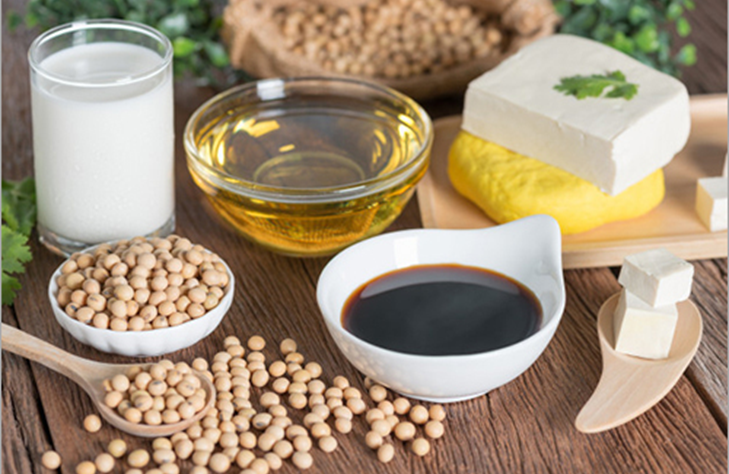INTRODUCTION
What is soy lecithin? Lecithin is a food additive that comes from several sources – one of them being soy. It’s generally used as an emulsifier, or lubricant, when added to food, but also has uses as an antioxidant and flavor protector.
Soy lecithin is composed of choline, fatty acids, glycerol, glycolipids, phospholipids, phosphoric acid and triglycerides.
The diverse forms in which lecithin is available – fluid, powder and granules – make it even more suitable to use as per industry specific demands. With additional processing, fluid lecithin can also be hydrolysed, fractionated, hydroxylated and acetylated for very specific industry applications.
Manufacture
Soy Lecithin is made from fresh gums, during de-gumming of Soybean Oil obtained from Soybean seeds.
| Synonyms | Lecithin from Soybean |
| CAS no. | 8002-43-5, 8030-76-0 |
| EINECS no. | 232-307-2 |
| Molecular formula | C42H80NO8P |
| Molecular weight | 643.9 |
Applications
It is used in human food, pharmaceuticals, animal feed, paints, and other industrial applications.
| In food industry as an emulsifier, stabilizer, lubricate, release agent, antioxidant and dispersant. |
| In the pharmaceutical industry, it acts as a wetting agent, stabilizing agent and a choline enrichment carrier, helps in emulsification and encapsulation, and is a good dispersing agent. It can be used in manufacture of intravenous fat infusions and for therapeutic use. |
| In animal feed, it enriches fat and protein and improves pelletization. |
| In the paint industry, it forms protective coatings for surfaces with painting and printing ink, has antioxidant properties, helps as a rust inhibitor, is a color-intensifying agent, catalyst, conditioning aid modifier, and dispersing aid; it is a good stabilizing and suspending agent, emulsifier, and wetting agent, helps in maintaining uniform mixture of several pigments, helps in grinding of metal oxide pigments, is a spreading and mixing aid, prevents hard settling of pigments, eliminates foam in water-based paints, and helps in fast dispersion of latex-based paints. |
| Also, may be used as a release agent for plastics, an anti-sludge additive in motor lubricants, an anti-gumming agent in gasoline, and an emulsifier, spreading agent, and antioxidant in textile, rubber, and other industries. |
SPECIFICATIONS – Soy Lecithin liquid (food grade)
| Test | Unit | Specification |
|---|---|---|
| Appearance | – | Semi liquid, Viscous Syrup |
| Colour | – | Yellow-Brown |
| Odour | – | Typical predominantly Soy |
| Taste | – | Characteristic of Soybean |
| Moisture | % | Max 0.1 |
| Acid Value | KOH/gm | Max 30 mg |
| Acetone insoluble matter | % | Min 60 |
| Hexane insoluble | % | Max 0.3 |
| Peroxide value | Me q /gm | Max 3.0 |
| Arsenic | ppm | Max 3.0 |
| GM detection | % | PCR negative quality (less than 0.1) |
STORAGE
Store away from direct sunlight and in a cool & dry place
PACKING
1. Liquid – Drum, IBC, Flexi Tank & ISO Tank
2. Powder/Granules – 20/25 kg Corrugated Paper Box
Soy Lecithin offered by ExSyn is non-GMO & with Kosher/Halal certification.
No matter the quantity you need, our exceptional quality and service will make ExSyn your supplier of choice! If you need any additional information or SDS, please get in touch with us.
Iodine is anon-metallic, dark-grey/purple-black, lustrous, solid element. It is the heaviest and the rarest of stable halogens that can be found on the crust of earth.About fifty percent of all iodine produced and manufactured worldwide is used to form Organoiodine compounds. Iodine is an important element for many health-sustaining processes and essential for human thyroid health.
The product, acronymed Oct-NBE, is an organic compound with a cyclic ring system and a 8-membered hydrophobic chain. The structure renders the chemical special properties leading to its applications in diverse fields.
Nicotine is a hygroscopic, colorless to slight yellow, oily liquid, that is readily soluble in alcohol, ether or light petroleum. It is widely used recreationally as a stimulant and anxiolytic.
The product, acronymed ETD, is an organic compound with a fused bicyclic ring system and an ethylidene group. The structure renders the chemical special properties leading to its applications in diverse fields.
Sodium perchlorate monohydrate is the inorganic compound with the chemical formula NaClO4•H2O. It is the common existence form of sodium perchlorate, which can gradually absorb water in the air to form the monohydrate. Sodium perchlorate monohydrate is white rhombic crystal which is highly soluble in water and in alcohol. Its capacity to undergo redox reactions, liberating oxygen atoms, has been harnessed in the preparation of specialty chemicals, including pharmaceutical intermediates and fine chemicals.
Triphenylphosphine is a common organophosphorus compound that is frequently abbreviated as PPh3 or Ph3P. It is widely used in organic and organometallic compound synthesis because it is an effective reducing agent as well as a neutral ligand. At room temperature, PPh3 crystals are relatively air-stable and colourless.
Potassium chlorate holds significant importance across various industries due to its diverse applications. This white crystalline compound has been utilized for centuries as an essential ingredient in the production of matches, fireworks, and explosives, owing to its ability to release oxygen upon decomposition.
Podophyllotoxin is a non-alkaloid toxin lignan extracted from the roots and rhizomes of Podophyllum species. It is an organic heterotetracyclic compound that has a Furonaphthodioxole skeleton bearing a 3,4,5-trimethoxyphenyl substituent.
Octadecylphosphonic acid (ODPA), a versatile chemical compound, serves as a surfactant and dispersant in applications spanning coatings, lubricants, and corrosion inhibition. With its hydrophobic octadecyl chain linked to a phosphonic acid group, it excels in surface modification, boosting adhesion in metal surfaces.
